Posts Tagged ‘ice dam removal jerks’
Tuesday, November 15th, 2016
The Fundamental Underlying Cause of Most Ice Dams
We have spent a lot of time discussing the finer points about ice dams over the years. This Case Study is about pulling the focus back to the most global understanding of why ice dams happen.
What Causes Ice Dams
There are over a dozen factors that contribute to the formation of ice dams, all of which have been discussed in previous Case Studies. Fundamentally, only one condition MUST be met in order for ice dams to form: A temperature differential from one area of a roof assembly to another area, with the upper area being above 32° and the lower area being below 32°. See below.
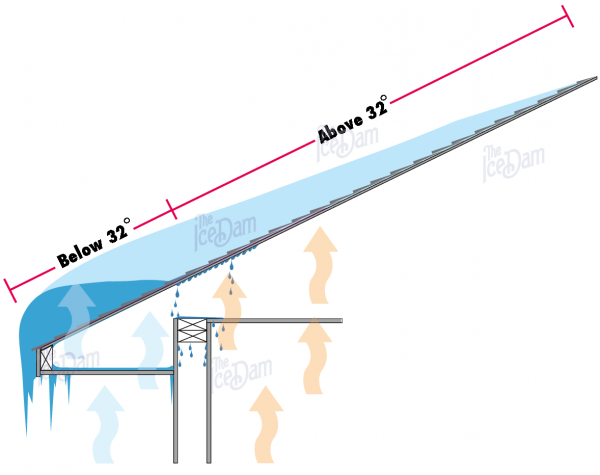
How it Works
This diagram demonstrates the basic concept behind ice dam formation. Snow melts in the area above 32°, water runs down to the area below 32° and refreezes. This cycle continues until an accumulation of ice forms that is large enough to block water from flowing naturally off the roof. The resulting ‘ice dam’ forces water to back up under the roofing materials and into the structure. There are many intersecting variables that cause the phenomenon described here. See below.
List of 7 Contributing Factors to Ice Dam Formation
- A period of outdoor temperatures ranging between 0°-10° at night followed by daytime temperatures between 10°-20°.
- Repeated snow falls that keep the roof loaded with new snow resulting in at least 6″ of coverage at all times.
- Thermal inefficiencies in the home that allow warmth to heat up the roof deck from the underside.
- Homeowner lifestyle that results in excessively heated spaces (More heat equals more roof snow melting).
- Roof pitch: Flatter roof pitches tend to be more affected by problematic ice dams.
- Eave depth: Smaller eaves tend to be more affected by problematic ice dams than deeper eaves.
- Age and construction style of home: Older homes tend to be more affected than newer homes.
To read more Case Studies click here.
Tags: about ice dams, best ice dam removal in minneapolis, best rated ice dam removal contractor, highest rated ice dam removal company in minneapolis, how do I know I have ice dams, how to tell if an ice dam is a problem, ice and snow removal, ice dam heat cable, ice dam prevention, Ice dam removal, ice dam removal jerks, twin cities ice dam remover
Posted in Ice Dams, Misc., Ice Dams: General Info | Comments Off on What Causes Ice Dams
Tuesday, November 1st, 2016
Steaming Ice Dams is the Fastest, Safest Way to Remove Ice Dams in Minneapolis
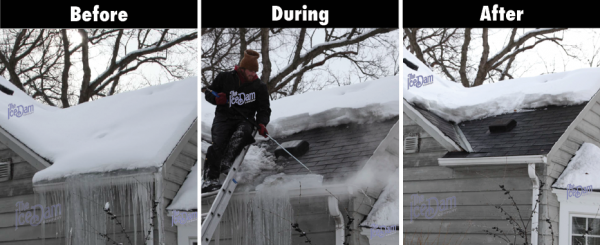
Why Use Steam?
When used properly, a commercial ice dam steamer is the best way to quickly and safely remove an ice dam or other unwanted ice accumulation. Like anything else, it’s possible to use a steamer improperly and damage property. That’s why you should hire an experienced ice removal company. Far more common is damage done to roofs using high temperature pressure washers. Most of our competitors that claim to be using steam are actually using high temp pressure washers. It’s the dirty little secret in our industry. Want to know the easiest way to tell the difference between a steamer and a high temperature pressure washer? If the gun has a trigger, it is NOT a steamer. It’s that simple. More information about Ice Dam Steamers vs High Temp Pressure Washers can be found here.
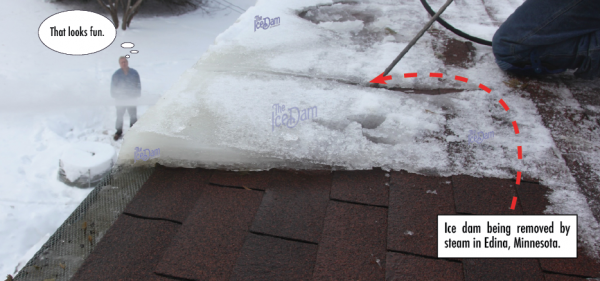
Ice Dam Company is a certified member of IDSAFE : the Ice Dam Steaming Association For Education.

Ice Dam Steaming Association For Education
To read more Case Studies click here.
Tags: about ice dams, best ice dam removal in minneapolis, best rated ice dam removal contractor, edina ice dam removal, edina ice dam steaming, highest rated ice dam removal company in minneapolis, ice dam removal jerks, ice removal company, ice removal professionals, lake minnetonka ice dam removal, minnepolis ice dam removal, orono ice dam removal, roof ice steaming, signs of an ice dam problem, twin cities ice dam remover, wayzata ice dam removal
Posted in Ice Dam Prevention, Ice Dam Removal, Ice Dams, Misc., Ice Dams: General Info | Comments Off on Ice Dam Removal by Steam
Saturday, October 15th, 2016
How the Distribution of Snow Can Affect the Formation of Ice Dams
Snow and Ice Dams
There is a complex relationship between snow and ice dams. Yes, you need snow to get ice dams. Snow is, after all, the fuel that feeds the formation and growth of ice dams. Furthermore, it is unlikely to get ice dams unless there is an ongoing layer of snow on your roof over a period of time (normally at least 7-10 days). But it takes more than just having snow on your roof to get ice dams. See Ice Dam Company Case Study #23 for a list of contributing factors. One factor that seldom gets discussed is the affect of wind on the formation and severity of ice dams. While this is not a primary factor, it is something worth exploring. This Ice Dam Case Study looks at the affect a thinning snow cover has when seen on a roof slope that also faces the sun. The affect described below is exacerbated by the presence of darker roofing materials as they absorb more solar energy than lighter materials.
Mountains and Roofs Share Something in Common
Any skiers out there? Wind speeds increase near the ridge of a roof just like the top of a mountain. Snow on one side of the ridge is often swept away while remaining in place just on the other side of the peak. This phenomenon can affect both sides of a roof if wind direction changes from day to day, leaving the snow coverage thin or non-existent on the upper few feet of the roof below the ridge.
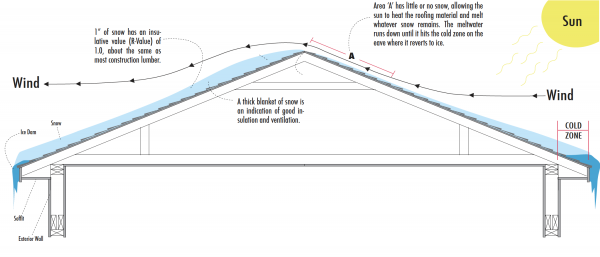
Condensation, The Silent Killer
The lack of an insulating snow blanket can allow heat from the inside of the home to meet cold exterior air in a thinner ‘conduction plane’. When heat hits a thin surface such as a roof decking, where there is a great temperature differential from one side to the other, condensation is also likely. Think of frost on old, single paned windows. The more space there is between the heat and cold, the more room there is for this interaction, greatly reducing the likelihood of condensation. A thick blanket of snow is a perfect insulator for this purpose. It creates more separation between the warmth being lost from the home and the frigid exterior air. Homes with thick snow coverage on their roofs generally seen as more efficient because heat is not escaping through the roofline to reduce the snow through melting.
To read more Case Studies click here.
Tags: about ice dams, best ice dam removal in minneapolis, best rated ice dam removal contractor, highest rated ice dam removal company in minneapolis, how do I know I have ice dams, how to tell if an ice dam is a problem, ice and snow removal, ice dam expert, ice dam removal jerks, ice removal company, minneapolis ie dam removal, steamer
Posted in Ice Dams, Misc., Ice Dams: General Info | Comments Off on Snow Distribution and Ice Dams
Sunday, July 3rd, 2016
The Factors that Determine Ice Dam Removal Cost and Pricing
Ice Dam Removal Pricing
Generally speaking, you can expect to pay somewhere between $300 to $600 per hour for ice dam removal with steam. As much as you may not want to hear this, with over 25 years of experience behind us, we can tell you that the primary driver for ice dam pricing is classic supply and demand. Every market will have a different demand for ice dam removal and a different supply of qualified contractors to perform that work. (See Econ101 from your freshman year for further details). Back to the word “qualified”. There are dozens of companies in the Twin Cities market right now who are using ice picks and hammers and axes to remove ice dams. They normally charge less per hour than ice dam steaming contractors. There are also scores of competitors using high temperature pressure washers and calling them steamers (hint: 2 of the top 3 Google results in Minnesota). Yikes. In the Minneapolis market we profit by following the work of the aforementioned “professionals” by repairing the damage they’ve done each winter with pics and pressure washers. It’s hurts to pay for ice dam removal. It’s extra painful to pay for repairing the damage left behind by losers.

Ice Dam Removal Speed
There are many factors that go into determining how long an ice dam takes to remove:
- Roof height (Higher = More difficult)
- Roof pitch (Steeper = More difficult)
- Snow load (More snow = More time)
- Site protections time (Property under the work area needs to be protected to prevent damage from falling ice and snow)
- Ice dam thickness (Thicker = More time)
- Ice dam depth (The further it has grown up the roof, the longer removal takes)
- Outdoor temps (Colder = More difficult)
- Ethics (Lower ethics = More time spent)
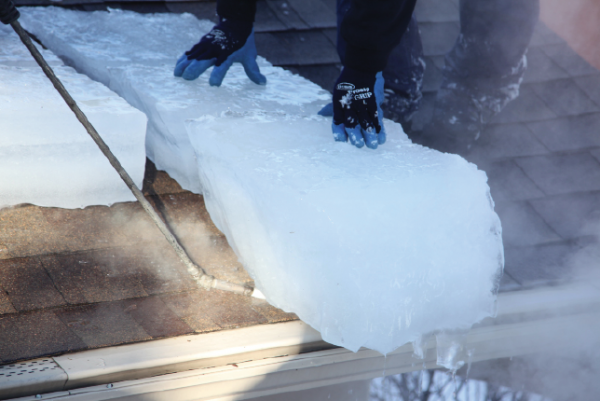
Having two members to the crew is not only important to safety, it is essential for efficiency. One guy cuts and one guy throws the ice chunks.
To Chunk or Not to Chunk
There is a big difference between ice dam removal COST and ice dam removal PRICING. Pricing is what one typically pays per hour for the work to be performed. Cost relates to how long it takes to do the job. In our list of the 8 factors that determine ice dam removal cost, #8 is the most important. That’s what the photos in this case study are meant to illustrate. Ethical ice dam removal guys do it like shown and they use steam, not high temperature pressure washers. It’s called ‘chunking’. The idea is simple. Use the steamer to cut the ice dam into chunks that can be picked up and thrown off the roof. Cutting ice is the part of the job that takes the longest. Add to cutting time, add to the job cost. The alternative is to use the steamer-or pressure washer if you’re totally smarmy-to methodically melt away ALL of the ice from the roof, one square inch at a time. As shown here, one only needs to actually melt about 5-10% of the ice in order to remove the ice dam. Make slots and undercut. It’s that simple. What the less ethical players do is also simple. Melt all of the ice, milk the clock and watch the dollars add up.
To read more Case Studies click here.
Tags: about ice dams, best ice dam removal in minneapolis, best rated ice dam removal contractor, commercial ice removal, edina ice dam removal, edina ice dam steaming, highest rated ice dam removal company in minneapolis, ice and snow removal, ice dam expert, ice dam removal jerks, ice removal company, minneapolis ice dam removal, roof ice steaming, twin cities ice dam remover
Posted in Ice Dam Prevention, Ice Dam Removal, Ice Dams, Misc., Ice Dams: General Info | Comments Off on List of Ice Dam Removal Cost Factors
Wednesday, June 22nd, 2016
The Truth About Gutters and their Relationship with Ice Dams
In 2011, Ice Dam Company owner Steve Kuhl wrote a nationally published article about ice dams for the Journal of Light Construction. One of the topics that receieved the most attention was the notion that gutters have nothing to do with ice dams. Here is a deeper look at that assertion.
There is a great deal of confusion and misinformation about the relationship between gutters and ice dams. Many people are under the misconception that gutters cause ice dams or that gutters filled with ice can cause water to back up into homes. Not true. We repeat. Gutters have nothing to do with ice dam formation or severity. For this reason, buying systems that heat gutters in order to prevent ice dams is a total and complete waste of money.
We know that ice dams occure when:
- Escaped heat from the inside of the home warms the roof deck.
- Melting snow results in water that runs down to a cold, unheated area of the roof (frequently the eave, as shown below).
- That water freezes, forming ice. After many of these cycles, that ice piles up to form an ice dam.
Study the illustrations below. These are identical eave designs, one with gutters, the other without. The Area B in the diagrams below is referred to as the ‘cold edge’ of the eave because heat from the interior of the home doesn’t travel that far. Fact One: Whether or not a home has gutters, a cold edge will still exist and this is where ice dams form. Fact Two: leaks from ice dams occur in Area A, at the leading, top edge of the ice dam where water–with nowhere else to go–is forced up under the roofing material and into the home. Put another way, if the home in Figure 2 had bad leaks inside, those leaks would not be eliminated whatsoever if we took a chainsaw and cut off the gutters along the red dashed line (C). Moreover, if we heated the gutters using a fancy electrical system, the likelihood of ice dams and the subsequent leaking would NOT be affected. Spend money on heat cables for the lower edge of your roof, not on heating the gutters only. High quality heat cables can be quite effective in preventing ice dams.
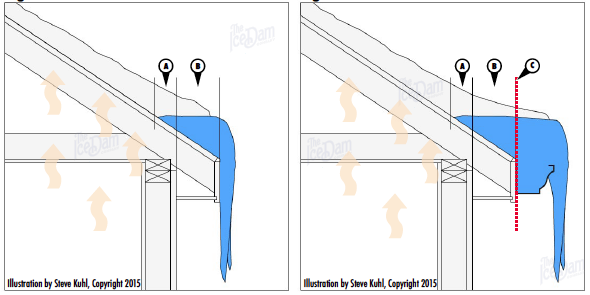
Figure 1: Ice Dam Without Gutters; Figure 2: Ice Dam With Gutters
None of this is to suggest that ice in gutters are harmless. We have seen many gutters damaged or destroyed by ice dams and that is a problem most homeowners would like to avoid. The point here is that, all else held equal, if a home is likely to get ice dams the addition or deletion of gutters will be of no consequence to the formation or severity of said ice dams. Likewise, for this reason, installing heated gutters or adding heating systems to existing gutters will have no affect whatsoever on the occurrence or severity of ice dams.
To read more Case Studies click here.
Tags: about ice dams, best ice dam removal in minneapolis, best rated ice dam removal contractor, commercial ice removal, edina ice dam removal, highest rated ice dam removal company in minneapolis, how do I know I have ice dams, how to tell if an ice dam is a problem, ice dam expert, ice dam removal jerks, identifying an ice dam, minneapolis ice dam removal
Posted in Ice Dam Heat Tape, Ice Dam Prevention, Ice Dam Removal, Ice Dams, Misc., Ice Dams: General Info | Comments Off on Ice Dams in Gutters: A Myth in the Making
Friday, May 20th, 2016
Where Do Ice Dams Normally Happen on Homes? A List of the Most Common Ice Dam Locations
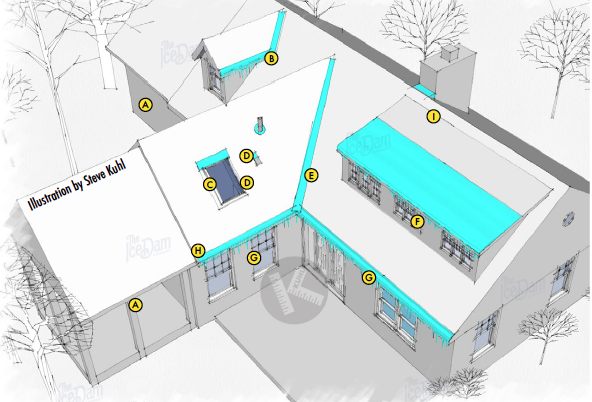
Where ice dams happen…and don’t happen:
- Ice dams seldom occur over unheated areas such as garages and porches (A).
- The valley areas of dormers frequently get ice dams (B).
- Ice dams often occur both below and above skylights. Ice dams above skylights are hard to see from the ground, making them some of the sneakiest to discover (C).
- Any openings through the roof – such as pipes and vents – are a good place for small ice dams for form (D).
- Valleys are very common areas for ice dam formation. It is important to never use hammers or chisels near valleys as the difference between a thorough ice removal job and valley damage is fractions of an inch (E).
- On roofs with a low pitch (angle) even a 1-2″ ice dam can cause significant leaking and interior damage (F).
- The eaves edge is the most common place to see ice dams. 80% of the dams we remove are found here (G).
- Interior rooms with vaulted ceilings are frequently associated with large ice dams. Bathrooms are often the worst. If you had recessed lighting to a vaulted ceiling, you are much more likely to have ice dams (H).
- Ice dams occasionally form around chimneys and furnace flues. Any place heat escapes through the roof line. Ice dams in these locations can be very, very small and still cause leaking (I).
To read more Case Studies click here.
Tags: about ice dams, best ice dam removal in minneapolis, best rated ice dam removal contractor, highest rated ice dam removal company in minneapolis, how do I know I have ice dams, ice dam expert, ice dam heat cable, ice dam removal jerks, identifying an ice dam, is my ice dam bad, minneapolis ice dam removal, twin cities ice dam remover
Posted in Ice Dam Prevention, Ice Dam Removal, Ice Dams, Misc., Ice Dams: General Info | Comments Off on Common Ice Dam Locations on a Home
Monday, December 22nd, 2014
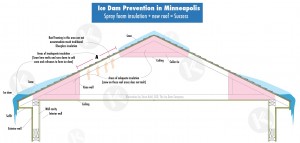
Attic insulation contractor addresses ice dams with new insulation in Edina
Using the words ‘ice dam prevention’ in Minneapolis is a dangerous gamble. It’s true that with certain efforts one can greatly reduce the chances of getting ice dams, it is almost impossible to prevent them altogether. For example, we can do a top quality insulation and ventilation retrofit on a Minneapolis attic only to be thwarted by the fact that the homeowner likes to keep the attic at 90 degrees in the winter. That is a formula for ice dam disaster in Minnesota. There are a number of methods to employ in preventing ice dams (or reducing their severity, in some cases). Here are links to two such approaches used by our sister company, Kuhl’s Contracting, a nationally recognized ice dam prevention company.
Approach to ice dam prevention in Minneapolis #1
Approach to ice dam prevention in Minneapolis #2
Homeowners looking to fix or at least minimize the risk of ice dams in Minnesota are wise to look at the key contributing factors that spawn ice dams. Those are, the weather, insulation, ventilation, air leaks, personal lifestyle and home architecture. We are frequently successful in reducing and/or eliminating ice dams through the use of high performance spray foam insulation systems in combination with enhanced attic ventilation.
Here is another helpful link on the topic of home insulation and ice dam prevention in Minneapolis
Tags: about ice dams, best ice dam removal in minneapolis, best rated ice dam removal contractor, commercial ice removal, construction site ice removal, edina ice dam removal, how to file an insurance claim for an ice dam, ice and snow removal, ice dam expert, ice dam removal jerks, Ice dam Steaming, ice removal company, ice removal from concrete, ice removal professionals, minneapolis ice dam removal, orono ice dam removal, roof ice steaming, signs of an ice dam problem, wayzata ice dam removal
Posted in Ice Dam Prevention, Ice Dams, Misc. | Comments Off on Minneapolis Ice Dam Prevention
Thursday, December 18th, 2014
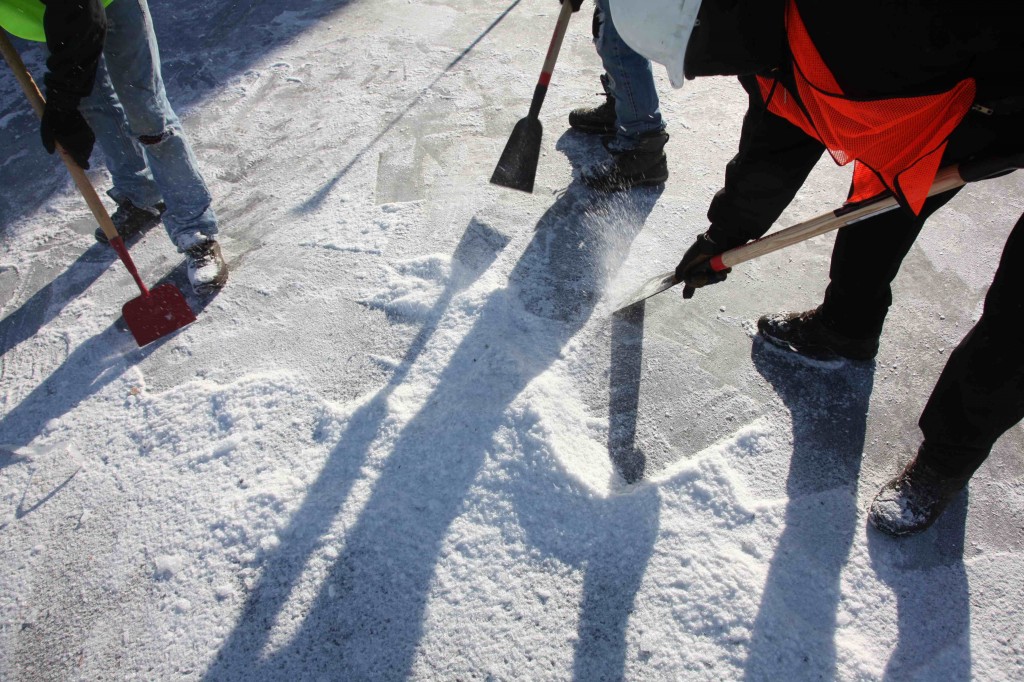
construction site ice removal, commercial ice removal, ice accumulation removal minneapolis, ice dam company
We have been called by property managers and builders to remove ice from a number of odd areas in Minneapolis over the years. Heck, we have even removed ice during the summer around cooling condensers at a chemical plant. While we frequently use our high-end steamers for the removal of ice, sometimes they are simply not appropriate. Such was the case on a recent job at a hotel under construction. A thin layer of ice had built up on the surface of a concrete floor that was perfectly flat…and huge. Using steamers in this application would have possibly resulted in making the problem worse by adding more water to the situation. While our steamers don’t generate much water, any time you melt ice, water is the result. Hence, my concern was that we would create a big mess. I suggested that we go old-school on this challenge. I sent three of my guys out there to hack and chip the ice with shiny, new scrapers. The resulting ice chips were simply blown and swept off the concrete, allowing the project carpenters to follow closely behind and lay out the wall framing without concern. It’s a low tech solution but sometimes that is what’s best.

Ice removal minneapolis commercial ice removal from flat surface
Tags: about ice dams, best ice dam removal in minneapolis, best rated ice dam removal contractor, commercial ice removal, construction site ice removal, edina ice dam removal, how to file an insurance claim for an ice dam, ice and snow removal, ice dam expert, ice dam removal jerks, Ice dam Steaming, ice removal company, ice removal from concrete, ice removal professionals, minneapolis ice dam removal, orono ice dam removal, roof ice steaming, signs of an ice dam problem, wayzata ice dam removal
Posted in Ice Dams, Misc. | Comments Off on Commercial ice removal in Minneapolis
Wednesday, December 18th, 2013
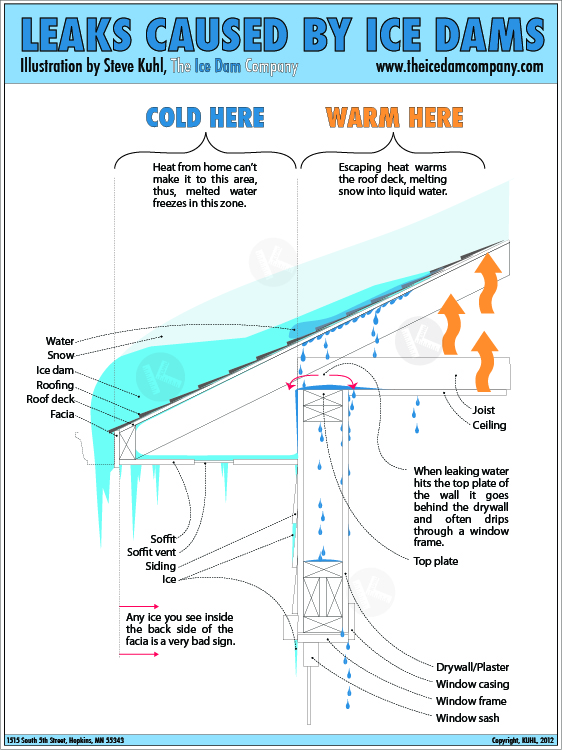
Best rated ice dam removal in minneapolis
I’ve been working on a new graphic to describe the basics for homeowners in Minneapolis to identify a problematic ice dam. It’s true that some ice dams cause no problems. The key consideration in determining whether or not an ice dam is a current problem is all about where you see ice. Study this drawing closely and you will see that any ice behind the facia is a bad sign. Ice through the soffit, down the exterior wall or through the window frame is very bad thing. Leaks caused by ice dams minneapolis
Tags: about ice dams, best ice dam removal in minneapolis, best rated ice dam removal contractor, gutter ice, highest rated ice dam removal company in minneapolis, how do I know I have ice dams, how to tell if an ice dam is a problem, ice dam prevention, Ice dam removal, ice dam removal jerks, identifying an ice dam, is my ice dam bad, Roof Leak, signs of an ice dam problem
Posted in Ice Dams, Misc. | Comments Off on How to tell if an ice dam is bad
Friday, December 13th, 2013
We received a call yesterday that was odd, even by our standards. The other strange part is that it was the second call in two days about the same issue. The homeowner noticed a bad smell coming from the shower and sink drains in her home in multiple locations. Moreover, there was a gurgling noise coming from the drains when the toilet flushed or when the other fixtures were used. The smell was so bad these poor people had to leave their homes. It was the smell of raw sewage, which ranks up there with the rankest of rank. Bummer indeed.
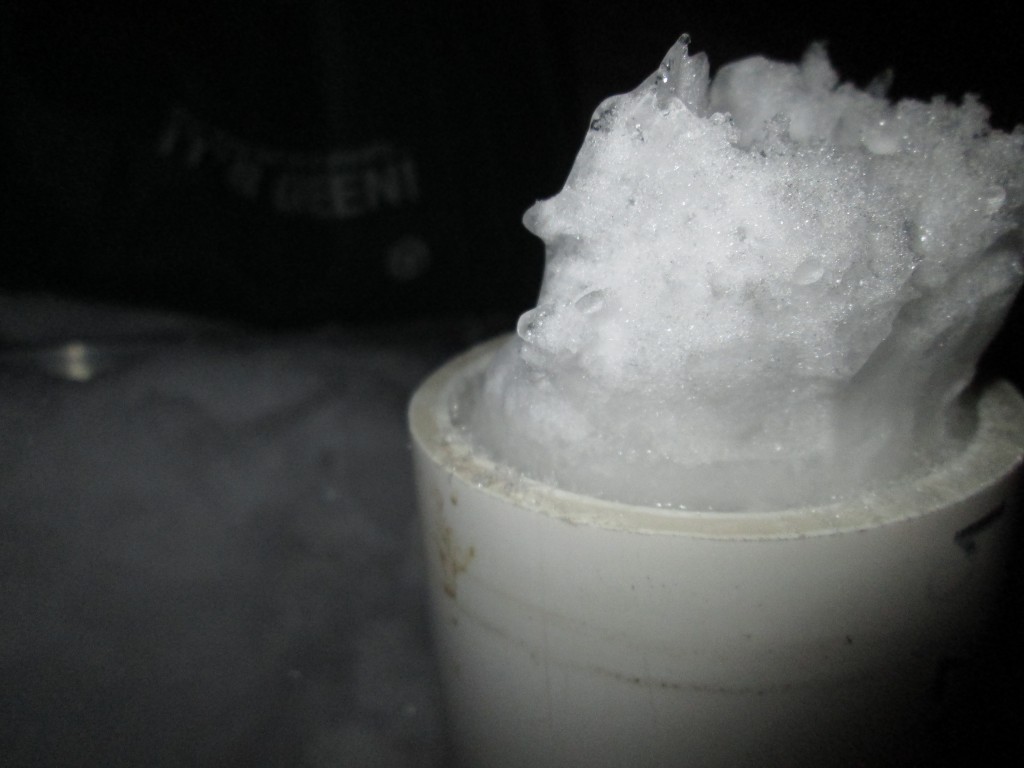
Plumbing vent plugged up with ice and snow
We sent one of our guys over there at 8pm in the dark to fix the issue because we felt so bad for these people. They had kids and the whole family was living at Grandpa’s house until the smell was figured out. Usually snow that falls on top of PVC plumbing vents just falls in and melts somewhere inside the system. In this case it piled up and formed a solid chunk of ice that completely blocked the pipe. We used a heat gun to quickly dislodge the ice and the problem was solved. We still can not figure out why this happened in the first place. Theoretically this could happen on every home in Minnesota but it doesn’t. We will be puzzling over this case for a while.
Tags: ice dam removal edina, ice dam removal jerks, lake minnetonka ice dam removal, minnepolis ice dam removal, orono ice dam removal, twin cities ice dam remover, wayzata ice dam removal
Posted in Ice Dams, Misc. | Comments Off on Plumbing Vent Blocked By Ice – A Mystery Smell Resolved



















